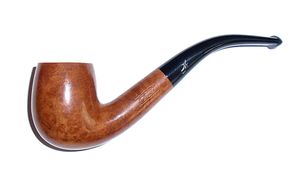Amiel
Raoul Amiel
History
The factory of Raoul Amiel near Philippeville in Algeria is the result of the briar industry there. By 1900 the French and Italian sources of briarwood in the Mediterranean are becoming rarer. The pipe industry had grown in a short period of time and a gigantic demand for this special rootwood was there. In 1905 rich fields of briar were discovered in Algeria, at that time still part of France. Within some years Algeria became an important exporter of so-called ebauchons that were exported world-wide. About eighty percent of the briar used in the pipe industry of that time originated from Algeria.


We had previously indicated that French undertakers together with English investors were considering to set up the industry of pipe making in Algeria. The raw material was sufficient available, moreover cheap labour was easy to get. The Amiel family reports the factory was originally financed by the Wassas Family. Unfortunately things changed after 1929.
The AMIEL family was a traditional pipe family. They had their origins in Nancy, France, which they left in 1870 during the German invasion. They first moved to Florence Italy before moving to Philippeville in French Algeria. RAOUL was a gifted engineer and designed and built the factory, which was very modern for the time. [1]

In 1932 the first pipe factory in Algeria opened its doors under the name Raoul Amiel. A mysterious factory of which little history is known. Certainly the techniques for making the pipes came over from Saint-Claude so that the pipes are hard to distinguish from the French counterparts.
The factory named Amiel is heading with success. The product soon reached a high grade of perfection and soon competed with the French products. Even so, Amiel was selling a greater deal of his products in Saint-Claude, where the pipes received a French mark to be exported world-wide.
Despite of the large production and the excellent trade the success of the factory is unclear to us now. After the founding the factory worked till the late 1950's. Possibly the mark thereafter was sold and the production moved to another place. Anyhow, pipes under the name Amiel were kept alive till they disappeared from the marked somewhere around 1980. Certainly that fact is related to the declining interest in the tobacco pipe in general.
Characteristics
Looking at the shape chart of Amiel we notice that these briars are most specific for the time of production, the era between 1935 and 1955. The tobacco pipe was still popular in that period and the smoker was looking for classical shapes with subtle contemporary characteristics. In the assortment we meet with the famous néogène, billiard, boule and pot. Next to these we find the bulldog in different styles. This shape was born already before the year 1900 and was modernised again and again in different shape variations.
Finally there are fashionable bowl shapes that became popular in the 1930's like the tomato and the Albert, bowl shapes derived from the then popular streamline. Fully in accordance to the fashion after 1940 a part of these pipes received facets around the bowl. The wood of the bowl was flattened so that the polished parts gave the pipe an extra shine. This look is characteristic for the tobacco pipe in the 1940's and 1950's.
The quality is not only expressed in the beautiful briar used, but also in the sharp cut of the models. Almost all the pipes have perfection and nice balance in shape. Also the mounting with the vulcanite stems are perfect, while an excellent type of rubber is used. In short, the product reflects the craftsmanship of that time.
The Smokiana pipeshop selection
Smokiana pipeshop in Amsterdam has been lucky to purchase a series of these Amiel pipes. It concerns products produced pre 1955 that were exported to a trade house where they ended in their stock and kept stored for over half a century. The Amiels are so specific in fashion and taste that they fully reflect the pipe fashion from the nineteen thirties and forties. As noted they are of excellent quality briar with a perfect matching stem. Also in their grains they are beautiful. Finally these vintage pipes have a perfect surface without fillings. As stated, all these pipes are without stamped mark. Prices run from Euro 90 for the common ones up to 140 Euro for the finest qualities.
- Example and details, courtesy Doug Valitchka
- ↑ E-mail from Jacques Le Moigne, great grand son of Justine AMIEL, Raoul AMIEL’s sister.




